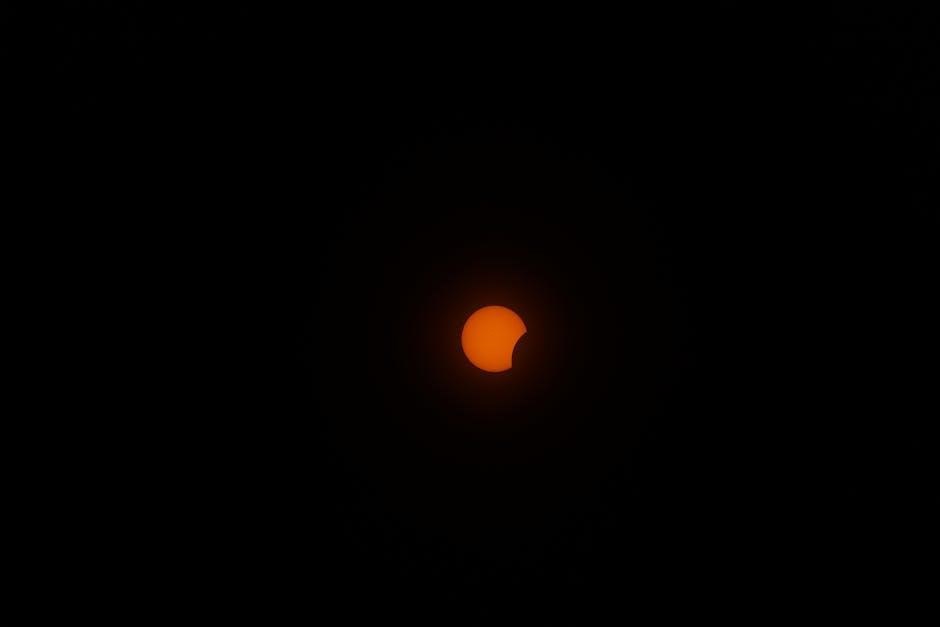This manual guides users through aligning their telescope accurately‚ ensuring optimal performance. It covers one-star‚ two-star‚ and manual vs. automatic alignment methods‚ plus troubleshooting tips for precise stargazing.
Overview of the Star Aligner System
The Star Aligner System is a advanced tool designed to simplify and enhance telescope alignment. It utilizes StarSense technology to automatically identify and center stars‚ streamlining the alignment process. The system supports both one-star and two-star alignment methods‚ offering flexibility for users. Manual and automatic modes cater to different skill levels‚ ensuring precise targeting. By leveraging reference stars and diagnostic tools like NIRCam‚ the system achieves high accuracy. Regular updates and maintenance ensure optimal performance. This robust system is essential for astronomers seeking precise telescope calibration and consistent results‚ making stargazing more efficient and enjoyable.
Importance of Proper Telescope Alignment
Proper telescope alignment is crucial for achieving precise targeting and clear observations. Misalignment can lead to blurry images‚ difficulty locating celestial objects‚ and reduced performance. Accurate alignment ensures the telescope’s mount and optics work harmoniously‚ delivering sharp focus and stable tracking; Regular calibration and adjustment are essential to maintain optimal functionality. Proper alignment also enhances the overall stargazing experience‚ allowing users to explore the night sky with confidence and efficiency. By following alignment procedures‚ astronomers can unlock the full potential of their telescope‚ ensuring accurate and enjoyable observations every time.
Basic Components of the Star Aligner
The Star Aligner system consists of key components designed to enhance telescope accuracy. The telescope mount provides stability and precise movement‚ while the StarSense technology enables automatic alignment. The hand control offers intuitive navigation‚ guiding users through alignment steps. Additional accessories like eyepieces and finder scopes improve targeting precision. Together‚ these elements streamline the alignment process‚ ensuring accurate celestial observations. Proper use of these components is essential for maximizing the telescope’s performance and achieving sharp‚ clear views of the night sky. Regular maintenance of these parts ensures optimal functionality and longevity of the system.

Types of Alignment Methods
The Star Aligner supports one-star‚ two-star‚ and manual vs. automatic alignment methods. These techniques ensure precise telescope calibration for accurate celestial observations and optimal performance.
One-Star Alignment
A one-star alignment is a straightforward method that relies on a single star to calibrate the telescope. It is ideal for beginners or when time is limited. To perform this‚ select a bright‚ easily identifiable star‚ center it in the eyepiece‚ and synchronize the telescope’s coordinates. While less precise than two-star alignment‚ it provides decent accuracy for casual observations. This method is particularly useful in areas with limited star visibility or when setting up quickly. However‚ for more precise alignment‚ especially for astrophotography‚ a two-star method is recommended. Always ensure the selected star is clear and free from obstructions for best results.
Two-Star Alignment
The two-star alignment method enhances accuracy by using two distinct stars to refine the telescope’s positioning. This process involves centering the first star in the eyepiece‚ then slewing to the second star and repeating the process. By leveraging two reference points‚ the system adjusts for potential misalignment issues‚ improving overall pointing precision. This method is recommended for more critical observations‚ such as astrophotography‚ where accuracy is paramount. Ensure both stars are bright and widely separated for optimal results. Proper execution of this method minimizes errors and ensures the telescope’s mount is calibrated effectively for subsequent use. It is a step-up from the one-star alignment in terms of accuracy and reliability.
Manual vs. Automatic Alignment
Manual alignment requires users to identify and center stars themselves‚ offering more control but demanding time and skill. Automatic alignment‚ like StarSense‚ streamlines the process by identifying stars without manual intervention‚ saving time and improving efficiency. While manual alignment is ideal for experienced users seeking precision‚ automatic alignment is perfect for beginners or those prioritizing convenience. Both methods ensure accurate telescope calibration‚ but the choice depends on personal preference and observing goals. Automatic systems reduce human error‚ while manual methods allow for customization and deeper engagement with the alignment process.

Choosing the Right Alignment Stars
Selecting bright‚ visible stars is crucial for accurate alignment. Avoid obstructions and ensure stars are optimally positioned for your telescope’s field of view and sky conditions.
Criteria for Selecting Alignment Stars
Selecting the right alignment stars is crucial for accurate telescope alignment. Bright‚ visible stars near the celestial equator are ideal‚ as they minimize pointing errors. Avoid stars too close to the horizon or obscured by obstructions. Ensure the stars are within the telescope’s field of view and suitable for the alignment method chosen. For one-star alignment‚ a single bright star suffices‚ while two-star alignment requires two distinct stars spaced apart. Proper selection enhances accuracy and ensures optimal performance for stargazing or astrophotography. Brightness and clarity are key to reducing alignment errors and achieving precise telescope calibration.
Using Bright Stars for Better Accuracy
Bright stars are essential for achieving precise telescope alignment‚ as they provide clear visibility and minimize errors. Their high luminosity makes centering easier‚ ensuring accurate calibration. Using bright stars reduces the risk of misalignment‚ especially in methods like one-star or two-star alignment. This clarity is vital for systems like StarSense‚ which rely on clear star images for diagnostics. Bright stars also aid in refining alignment and troubleshooting issues. Their visibility ensures the telescope’s optics and mount function optimally‚ delivering sharp images and precise tracking for astrophotography or observational astronomy‚ as seen in the James Webb Space Telescope’s alignment process.
Avoiding Obstructions During Alignment
Obstructions like trees‚ buildings‚ or power lines can disrupt telescope alignment by blocking the view of alignment stars. Ensure a clear line of sight to the selected stars to maintain accuracy. Identify potential obstructions beforehand and reposition the telescope if necessary. Manual alignment modes‚ such as StarSense‚ allow users to work around obstacles by selecting alternative star fields. Regularly updating telescope software and calibrating the mount can also help mitigate issues caused by obstructions. Clearing the area ensures smooth alignment‚ especially when using bright stars or multi-star alignment methods for precise astrophotography or deep-space observations.

Manual Alignment Process
The manual alignment process involves centering the first star‚ slewing to the second‚ and adjusting as needed. This ensures precise telescope calibration for accurate observations.
Preparation for Manual Alignment
Preparation is crucial for successful manual alignment. Begin by setting up your telescope on a stable platform and ensuring all accessories are securely attached. Power on the device and allow it to initialize. Select a clear‚ dark sky location with minimal obstructions. Choose bright‚ easily identifiable stars for alignment‚ avoiding those near the zenith. Center the first alignment star in your finder scope‚ then use directional keys to fine-tune its position in the eyepiece. Ensure the telescope mount is balanced and all cables are properly connected. Update your telescope’s software and verify the time‚ date‚ and location settings for accuracy. Finally‚ perform a quick focus adjustment on the finder scope to ensure sharp star images. Proper preparation ensures a smooth and precise alignment process.
Centering the First Alignment Star
Centering the first alignment star is a critical step in manual alignment. Locate a bright‚ easily identifiable star using your finder scope. Once the star is in the finder’s field of view‚ use the directional keys to slowly move the telescope until the star appears in your eyepiece. Adjust the focus to ensure the star is sharp and well-defined. Use fine adjustments to center the star precisely‚ ensuring it is symmetrical within the eyepiece’s field of view. Proper centering is essential for accurate alignment and optimal telescope performance. Take your time to achieve precise centering for the best results.
Centering the Second Alignment Star
After completing the first alignment star‚ select a second star that is ideally positioned opposite to the first for optimal accuracy. Use the directional keys to guide the telescope toward the second star. Once the star appears in the finder scope‚ switch to the eyepiece to fine-tune its position. Adjust the telescope’s movement slowly to center the star precisely. Ensure the star is sharp and symmetrical within the eyepiece’s field of view. Proper alignment of the second star enhances the telescope’s tracking accuracy. Repeat the centering process carefully to achieve the best results for precise celestial observations.
Refining the Alignment
After centering the second alignment star‚ refine the telescope’s alignment by making precise adjustments. Use the directional keys to fine-tune the telescope’s position‚ ensuring the star remains centered in the eyepiece. For systems equipped with advanced features like StarSense or NIRCam‚ the telescope may automatically adjust based on the star’s position. If manual adjustments are needed‚ refer to the telescope’s controls to make subtle corrections. This step ensures accurate tracking and minimizes pointing errors. Once satisfied‚ confirm the alignment to lock in the adjustments. Regular refining enhances observational accuracy‚ especially for astrophotography or deep-space object tracking.

Troubleshooting Manual Alignment Issues
Common issues during manual alignment include misaligned stars‚ pointing errors‚ or focus problems. If the telescope fails to center the star‚ check the eyepiece focus and ensure the star is within the finder scope’s field of view. Misalignment due to flexure or mechanical stress can occur‚ especially during long exposures. Adjust the telescope’s position slowly and precisely‚ avoiding sudden movements. For persistent issues‚ recalibrate the mount or restart the alignment process. Regular maintenance‚ such as updating software and ensuring proper telescope balance‚ can prevent recurring problems and improve overall alignment accuracy for clearer observations.

Using StarSense Technology
StarSense Technology enables automatic alignment by capturing images of the night sky‚ eliminating the need to manually identify stars. It enhances accuracy and streamlines the alignment process.
StarSense Manual Alignment offers a customizable approach to telescope alignment‚ allowing users to select specific areas of the sky for the system to analyze. This feature is particularly useful in environments with obstructions‚ such as trees or buildings‚ as it enables users to work around these challenges. By manually selecting three distinct regions for the camera to solve‚ StarSense provides greater control over the alignment process. This method is ideal for experienced users seeking precision and flexibility. However‚ it requires more user interaction compared to fully automatic modes‚ making it a powerful tool for tailored alignment needs.
How StarSense Improves Alignment Accuracy
StarSense enhances alignment accuracy by capturing high-resolution images of the night sky and using advanced algorithms to identify star patterns. This technology enables precise telescope positioning‚ ensuring accurate alignment with celestial objects. By analyzing multiple reference points‚ StarSense minimizes errors and adapts to environmental conditions‚ such as atmospheric disturbances‚ for sharper images. Real-time adjustments further optimize alignment‚ making it ideal for astrophotography. This system streamlines the process‚ reducing the need for manual corrections and delivering consistent results. Its ability to adapt to varying conditions ensures superior performance‚ making it a reliable choice for achieving precise telescope alignment.
Customizing Alignment with User Auto Align
User Auto Align allows users to customize telescope alignment by selecting specific reference stars‚ ensuring optimal positioning for their observing location. This feature minimizes pointing errors and adapts to local sky conditions‚ enhancing accuracy. By enabling users to define alignment points around obstacles like trees or buildings‚ it offers flexibility. Real-time adjustments are made based on the selected stars‚ improving overall performance. This customization capability ensures precise alignment‚ making it ideal for various observing scenarios. The ability to tailor alignment to individual needs maximizes telescope functionality and user satisfaction‚ providing a more efficient stargazing experience.

Maintenance and Calibration Tips
Regularly inspect and clean optical surfaces‚ lubricate moving parts‚ and update software for optimal performance. Calibrate the mount and align mirrors for precise telescope operation and accuracy.
Regular Maintenance for Optimal Performance
Regular maintenance ensures your telescope operates at peak efficiency. Clean optical surfaces with a soft‚ dry cloth to prevent dust buildup. Lubricate moving parts annually to maintain smooth motion. Check for software updates and install the latest version to enhance functionality. Inspect the mount for tightness and balance to prevent drift. Additionally‚ align the primary mirror and finder scope periodically for accuracy. Store the telescope in a dry‚ cool place to protect against humidity and temperature fluctuations. By following these steps‚ you can extend the lifespan of your equipment and ensure precise star alignment every time.
Calibrating the Telescope Mount
Calibrating your telescope mount is essential for accurate tracking and alignment. Begin by ensuring the mount is properly balanced and levelled. Use the alignment stars to synchronize the motor’s position with the celestial coordinates. Adjust the backlash compensation to minimize mechanical play‚ ensuring smooth movement. Perform a star alignment procedure to update the mount’s internal model. Regular calibration prevents pointing errors and improves tracking accuracy over time. Follow the manufacturer’s instructions for specific calibration steps‚ as different mounts may require unique procedures. Proper calibration ensures precise star alignment and optimal performance during observation sessions.
Updating Telescope Software
Regular software updates are crucial for maintaining your telescope’s performance and alignment accuracy. Check the manufacturer’s website for the latest firmware and software versions. Download and install updates using the provided instructions. Ensure the telescope is connected to a power source during the update to prevent interruptions. Updating enhances features‚ improves alignment precision‚ and fixes potential bugs. For instruments like NIRCam‚ updates may include diagnostic adjustments for mirror alignment. Always follow the manufacturer’s guidelines to avoid errors. Keeping your telescope’s software up-to-date ensures optimal functionality and alignment capabilities for precise stargazing experiences.

Troubleshooting Common Issues
Identify and correct pointing errors‚ address misalignment due to flexure‚ and fix focus issues in the finder scope. Consult the manual or support for guidance and ensure stability for accurate alignment.
Identifying and Correcting Pointing Errors
Pointing errors occur when the telescope fails to accurately locate or center alignment stars. To identify these issues‚ check the telescope’s alignment accuracy and ensure proper calibration. If the scope consistently misses targets‚ verify the mount’s polar alignment and balance. Misalignment due to flexure or mechanical stress can also cause pointing errors. To correct‚ recalibrate the mount‚ adjust the balance‚ and ensure all cables are secure. Use diagnostic tools like NIRCam for fine adjustments and consult the manual for specific troubleshooting steps. Regular maintenance and software updates can prevent recurring issues‚ ensuring precise alignment and optimal performance for stargazing sessions.
Addressing Misalignment Due to Flexure
Misalignment from flexure occurs when the telescope’s structure shifts under weight or stress‚ affecting pointing accuracy. To address this‚ ensure the mount is sturdy and balanced. Use a sturdy tripod and avoid overloading the scope. Regularly check and tighten all connections. During alignment‚ use reference stars to compensate for flexure-induced errors. Periodic recalibration and using backlash compensation can minimize the impact. For advanced setups‚ consider using auto-guiding or mechanical improvements to reduce flexure effects‚ ensuring sharper images and precise tracking during astrophotography or deep-space observations. Regular maintenance and adjustments will help maintain optimal alignment and performance over time.
Fixing Focus Issues in the Finder Scope
If the finder scope is out of focus‚ it can hinder accurate star alignment. To fix this‚ ensure the eyepiece is properly focused by adjusting the focus knob until the crosshairs are sharp. Next‚ center a bright star in the finder scope and fine-tune its focus by gently twisting the objective lens. Clean the lens if smudged or dirty‚ as this can blur the view. If focus issues persist‚ check for loose connections or obstructions. Proper focus ensures precise alignment and clearer views‚ enhancing overall telescope performance and alignment accuracy for better stargazing experiences.

Best Practices for Alignment
Best practices for alignment involve using bright stars for accuracy‚ ensuring a stable setup‚ referencing stars‚ and avoiding obstructions to minimize pointing errors for precise operations‚ ensuring optimal performance.
Ensuring Stable Telescope Setup
A stable telescope setup is crucial for accurate alignment and optimal performance. Use a sturdy tripod and ensure the mount is properly balanced. Level the tripod on firm‚ even ground to prevent wobbling. For polar-aligned mounts‚ accurately align the wedge with the celestial pole. Avoid loose or uneven surfaces that could cause vibrations. Secure all accessories to maintain balance. Additionally‚ use bright stars for alignment to enhance accuracy. Regularly check and tighten all connections to ensure stability. Proper setup ensures precise star tracking and focusing‚ making the alignment process smoother and more reliable for exceptional stargazing experiences.
Using Reference Stars for Accuracy
Using reference stars is essential for achieving precise telescope alignment. Select stars that are bright and widely spaced to minimize errors. For one-star alignment‚ choose a star near your target’s celestial coordinates. In two-star alignment‚ pick two stars that form a diagonal or spread across the sky. Avoid stars too close to the horizon or behind obstructions. Use the brightest stars for better accuracy‚ as they are easier to center. Ensure the telescope’s finder scope is calibrated to these stars for consistent results. Properly aligned reference stars ensure your telescope tracks objects accurately‚ making observations and astrophotography more successful.
Documenting Alignment Results
Documenting alignment results helps track performance and refine techniques. Record the alignment method used‚ selected stars‚ and environmental conditions. Note the telescope’s response and accuracy achieved. Log any adjustments made during the process. Over time‚ this data reveals patterns in alignment success or issues. Use a logbook or digital tool to organize results‚ including dates and times. This documentation aids in troubleshooting and maintenance. Reviewing past alignments helps identify recurring problems‚ such as mechanical adjustments or software updates needed. Consistent documentation enhances your ability to achieve precise alignments and ensures optimal telescope performance for astrophotography and observation.

Advanced Alignment Techniques
Explore multi-star alignment‚ NIRCam diagnostic adjustments‚ and astrophotography-specific settings for precision. These techniques enhance accuracy and adapt to unique observing conditions‚ optimizing your telescope’s performance for advanced astronomy.
Multi-Star Alignment for Precision
Multi-star alignment enhances accuracy by using multiple reference stars‚ improving telescope positioning. This method reduces errors and provides better celestial tracking. By leveraging data from several stars‚ it compensates for mechanical tolerances and atmospheric distortions‚ ensuring sharper images. Advanced systems like NIRCam utilize multi-star alignment for diagnostic mirror adjustments‚ optimizing performance. This technique is particularly valuable for astrophotography‚ where precise alignment is critical. Multi-star alignment minimizes the need for frequent adjustments‚ allowing for longer‚ uninterrupted observation sessions. It represents a significant advancement in telescope calibration‚ offering hobbyists and professionals alike a more reliable and efficient alignment process.
Using NIRCam for Diagnostic Adjustments
NIRCam plays a pivotal role in refining telescope alignment by providing diagnostic data for mirror adjustments. During the alignment process‚ NIRCam captures images of a target star‚ allowing scientists to assess and fine-tune the telescope’s optics. This process involves adjusting the position of small optics within NIRCam to ensure precise focus. The data collected helps in correcting misalignments and optimizing the telescope’s performance. NIRCam’s diagnostic capabilities are essential for achieving the high-resolution imagery required for astrophotography and deep-space observations. This advanced technology ensures that the telescope’s mirrors work in harmony‚ delivering crisp and accurate celestial images.
Aligning for Astrophotography
Aligning your telescope for astrophotography requires precision to capture crisp‚ high-resolution images of celestial objects. Use the multi-star alignment method for enhanced accuracy‚ ensuring the mount tracks smoothly. Focus on bright stars to minimize errors and adjust the telescope’s orientation carefully. Utilize StarSense technology to automate alignment‚ reducing manual intervention. For long exposures‚ ensure the telescope’s focus remains stable and perform periodic focus checks. Proper alignment is critical for eliminating star trails and ensuring sharp images. Follow these steps to optimize your setup for stunning astrophotography results.
Bright stars enhance alignment accuracy by reducing positioning errors and improving focus. Their clarity aids in diagnostics‚ as seen in Webb’s use of HD 84406 for mirror adjustments.
Aligning your telescope involves selecting bright stars‚ centering them in the finder scope‚ and adjusting with direction keys. For one-star alignment‚ follow steps 1-7. Two-star alignment requires centering a second star for enhanced accuracy. Manual adjustments refine positioning‚ while StarSense technology automates the process. Regular updates and maintenance ensure optimal performance. Proper alignment is crucial for sharp images and precise tracking‚ especially for astrophotography. Always stabilize the setup and avoid obstructions for best results. Documenting alignment steps helps troubleshoot common issues like flexure or pointing errors‚ ensuring successful observing sessions.
Final Tips for Successful Alignment
- Always start with a stable telescope setup to ensure precise alignment.
- Use bright‚ high-magnitude stars for better accuracy and visibility.
- Adjust focus carefully before alignment to avoid blurry images.
- Avoid obstructions like trees or buildings during the alignment process.
- Regularly update your telescope’s software for improved performance.
- Document alignment results to refine techniques in future sessions.
- Practice manual adjustments to enhance your skills for challenging conditions.
By following these tips‚ you’ll achieve precise alignment and enjoy optimal stargazing experiences.